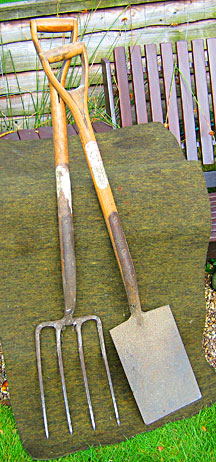Tips for Digging
Don't Underestimate the Effort
Hand digging your garden with a spade is hard work and if you haven't done any in a while, the effort required should not be underestimated. A half hour session of digging at a time is quite sufficient, after which you would be wise to find something a little less arduous to do while you recover.
It's important too that you work smoothly and steadily. Avoid adopting a jerky action and don't be tempted to rush the job. Try to develop an easy style that makes best use of the spade and the leverage action of the handle.
Just like a farmer ploughing a field, the idea of turning the soil over is to allow frost and winds to break up the clods of earth.
Read Also:
- Getting Started with Organic Gardening
- Garden Paths
- Planting a Hedge
- Laying a Hedge
- Planning a Rock Garden
- Dry Stone Walling
- Masonry Walls
- Gardening Skills
Timing is Important

Unless you are clearing a patch of overgrown ground for the first time you probably don't want to be digging over your garden during the growing season. To gain maximum benefit from nature you should aim to get the job done around late autumn to early winter.
Unfortunately the cold wet weather can make digging more difficult so you should choose a time when the soil is not too wet and sticky nor when the ground is frozen hard.
Basic Principles
In general, you should dig over the soil to a spade's depth. That way you are cultivating the fertile topsoil. If you dig too deep and bring the sub-soil to the surface, which may consist largely of clay, sand or chalk, then you will do more harm than good by ruining the fertility of the soil.
As you dig, you have the opportunity of introducing compost or manure into the garden, which you bury beneath the soil that you are turning over.
At the same time, take the opportunity of removing anything that is unwelcome such as the roots of perennial weeds and large stones, particularly items such as builder's rubble that has been buried in the garden.
Methodical Approach
In general you should work in strips along the length or breadth of the plot you are cultivating. Starting at one end of the plot, first dig out a trench about the depth of your spade and one or two feet wide. Transport the soil to the other end of the plot.
The next strip of soil is then turned over into the trench that has already been made. In so doing, another trench is formed further in from the edge of the plot. If you are introducing compost, this should be spread into the bottom of each trench as it is formed.
Having worked methodically across the plot of land, the soil from the first trench to be dug is used to fill in the final trench and so complete the work.
Read Also:
- Getting Started with Organic Gardening
- Garden Paths
- Planting a Hedge
- Laying a Hedge
- Planning a Rock Garden
- Dry Stone Walling
- Masonry Walls
- Gardening Skills
